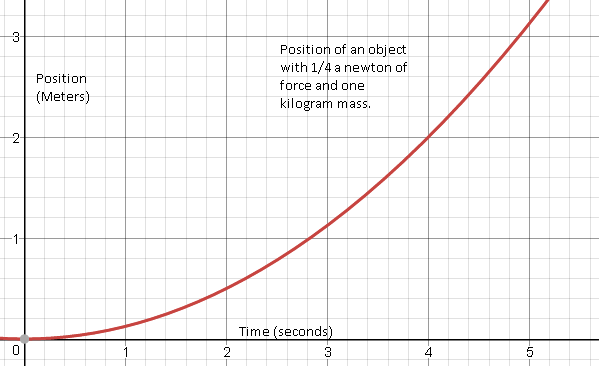Learning more one dimensional physics using some graphs -momuntum and force- physics for beginners - part two
Motion in one dimension is more complex than just 4 variables. Most other units are based on more basic units and over time it slowly gets more complex.
(This is the second if you missed the first click here)

( source)
Momentum and force are both based partly on the mass of the object
Mass is measured in kilograms. The mass and weight of something are different. The weight is a product of force on an object times it's mass while mass is always constant. For example, if you go up or down in an elevator you feel heavier as you go up and lighter as you go down. The Earth is so large that on average the force is almost the same everywhere you would normally go.
Mass is used more often in physics for multiple reasons. Mass does not change and mass is really a measure of how much matter is in an object. The more matter the harder it is to move.
Force and weight are the same thing
Force is mass times acceleration. In units the would be kilograms times meters a second squared or kg m /s^2. However, this has an alternate name that makes it easier to say and wright, newton. Newtons are abbreviated as N.
Some of you may be wondering how we can have weight without acceleration on us. We always go have acceleration on us, caused by gravity. Just because it is canceled out by the floor does not mean a force is not acting on us.
A constant force on an object causes a constant acceleration as long as the mass stays the same. For example if I push an object with 5 Newtons of force that weighs 1 kilogram I will be accelerating it by 5 meters a second squared.
If an object is accelerating at 8 meters a second squared and it's mass is 4 kilograms it has 32 newtons of force on it.

(source )
This is with a constant small force. To get the change in position you must multiply by seconds squared as with acceleration but also divide by the mass of the object. An object that has had 5 newtons of force on it for 3 seconds that has a mass of 10 kilograms would have gone 4.5 meters. (Assuming it started at 0 velocity and acceleration.)
Momentum is more often used in collisions and movement
Momentum is velocity times mass. Momentum has a direction like velocity, so after a collision or explosion it will equal 0 (assuming no movement beforehand) because it is conserved. For example imagine a small explosion where two pieces are shot off in either direction. One with a mass of 1 kilogram and one with a mass of 2 kilograms. The one that's mass is one kilogram will go twice as fast as the one that has a mass of two kilograms.
This idea also works in perfectly elastic collisions. (All energy after goes into movement, none lost to other types like heat.) They do not exist in large objects but as always in physics we imagine perfect situations. imagine a ball is going two meters a second to the right and with a mass of 5 kilograms. If it smacks into another ball with a mass of 1 kilogram in a perfectly elastic collision it will go 10 meters a second. (Assuming it hits it head on and is not made out of a material that would bounce back much, again perfect situations.)
units learned
Mass = Kilogram = Kg
Force = Newton = N = KgM/(s^2)
Momentum = KgM/s
coming up
2d motion
energy and power
Subscribe for more physics lessons
physics is fun yay! physics can save us all too. go, physics! thank you for this. people need to know.
Nice post. I love physics. Keep it comming!